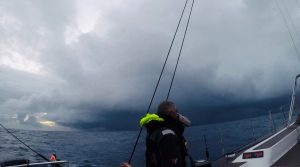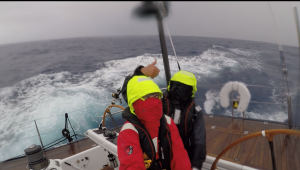Squalls
While particularly common in the tropics and during ocean passages, squalls can happen almost anywhere. For several reasons they can pose a threat to sailing yachts:
 Expect:
Expect:
· A considerable increase in wind speed:
It is not uncommon to experience windspeeds well above double the average windspeed. I have been sailing along very happily with full sail in 15 kts, then been hit by a squall which has over 40 kts under it…
· Heavy rain, reducing visibility:
It is easy to become disorientated when you can’t see the horizon and can’t read your instruments or compass. In the tropics the rain can be so heavy it stings your skin and reduces visibility to zero.
· Sudden windshifts:
The biggest danger with a big windshift is the accidental or ‘crash’ gybe. Unexpected and alarming at best, expensive damage and serious injury at worst.
It is important to identify when a squall may threaten your yacht because if left unchecked with no preparation the consequences are potentially disastrous.
Identifying a squall
In daylight they are pretty obvious, dark, grey clouds with often a visible wall of rain. On a dark night they are much less visible, and that is where your radar comes into its own. The rain in a squall should give a strong echo and show you exactly where it is. Get familiar with your ARPA function (Automatic Radar Plotting Aid). Select the squall and add as a target, after a few minutes the ARPA will have calculated the target’s course and speed. This will help let you know if you’re on a collision course and how long you’ve got to prepare.
Preparation
The most obvious preparation to make is to reduce sail. If passing through an area of squally activity it is prudent to put another reef in the mainsail and if flying a spinnaker get it down and properly stowed in good time. Furl away a good portion of the jib too, sacrifice some speed for safety until the squall goes through.
If you see a squall coming, let your crew know, make sure you’ve got support on deck to help reduce sail and make sure everything is properly stowed. Have a good look around the horizon and the AIS to see if there are any other vessels nearby. You may lose sight of them in the squall. Lifejackets are always a good idea as is clipping on. Get someone to check the hatches and pass up some rain jackets too before you get soaked.
Action
– As the wind line hits be prepared to ease the mainsheet to keep control of the yacht. If very windy or in doubt furl the jib away completely and just sail on your mainsail.
– Be prepared to bear away to depower the yacht and reduce the apparent wind speed, but keep an eye on your wind angle, and be prepared for a wind shift you don’t want to go through a gybe now!
– Another technique worth remembering if you don’t have sea room to bear away is to actually sheet the main in some and bring the yacht up to the wind. ‘Feather’ the main in the wind and ease in the big gusts. This way you have eliminated the risk of that nasty crash gybe.
– If the wind shifts, follow the wind around to keep a comfortable and safe wind angle.

The Aftermath
After a squall passes you are often left in a ‘lull’ with little or no wind. The rain will clear and you’ll probably be left wallowing around in the swell not making any progress. I always like to keep the sails reefed to stop them flogging in the light wind and start the engine. Motor clear of the squall to get back into the prevailing winds, or you might be stuck in the lull for a while. Once you’ve found the wind again, set your sails and keep sailing. It may be worth keeping that reef in the main though in case there is another squall to come.
Post by Skipper Harry Blazeby and photos by Freyboatie, both former Yachtmaster students of Learn2Sail and now Captain & professional crew of Swan 82.






